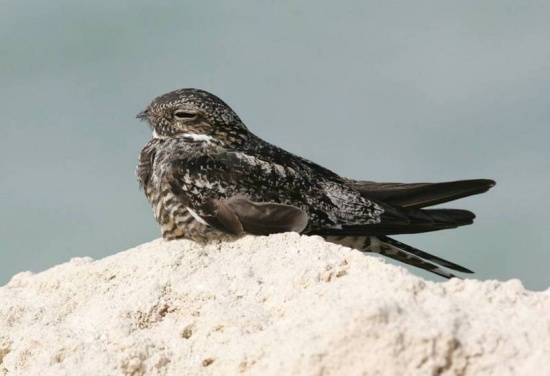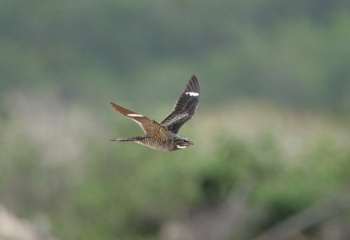- Chordeiles gundlachii
Identification
Adult
- 21.5 cm (8 1/2in) 50g, (1 3/4oz)
- Small to medium sized
- Generally well camouflaged plumage
- Dark with black, brown, grey and off white patterning on the upperparts and breast
- Long pointed black wings
- Tail is dark with white barring, notched
- Underparts are white with black bars
- There are 2 unconfirmed color morphs, a gray and a rufous type
- Plumages have little seasonal variation
- Adult Male
- White throat, white wing bar stretching across the primary flight feathers, shows in flight
- Tail has white subterminal band except central retrices
- Adult Female
- Yellowish brown throat patch
- Generally warmer plumage
- Patch on wing smaller
- Lacks subterminal band
- Juvenile
- Like female, but lacks throat patch
Similar Species
The most distinguishing characteristic to determine its identity from its closest relative the Common Nighthawk are the contrasting pale tertials near the back of the wings of a sitting bird. See references below for a discussion of the differences between the two.
Distribution
Antillean Nighthawk is known from the Greater Antilles, the Bahamas and Southern Florida, especially the Keys and Tortuga. However, recently they have been demonstrated to breed in e.g., Guadeloupe of the Lesser Antilles. The Antillean Nighthawk migrates out of its breeding range after raising its young. It still remains unknown where the birds spend the winter (South America is assumed to be the place).
Taxonomy
The Antillean Nighthawk was until recently, thought to be the same species as Common nighthawk.[2] Some authorities consider this species to be monotypic,[2] but others consider that there are 2 subspecies[1]
Subspecies
- C. g. vicinus:
- C. g. gundlachii:
- Cuba, Isle of Pines, Jamaica, Hispaniola, Puerto Rico, Virgin Islands
Habitat
Mainly belong in open country. Seashore with sparse vegetation and airfields. Wetlands
Behaviour
Crepuscular, but will fly throughout overcast days
Diet
They hawk for flying insects
Breeding
The Bahamas and Florida races C.g.vicinus lay one egg on the ground. C.g.gundlachii in the Greater Antilles lay two. Incubation (by the female) takes around 20 days and fledging another 20.
Vocalisation
Call: a short pik-adik usually heard overhead. (The Common Nighthawk makes a similar call, but it is not as consistent.)
Flight Pattern
The flight pattern is erratic, swift and light, with periods of gliding, where the wings are steeply inclined to the lateral axis.
References
- Clements, JF. 2008. The Clements Checklist of Birds of the World. 6th ed., with updates to December 2008. Ithaca: Cornell Univ. Press. ISBN 978-0801445019.
- Avibase
- Wikipedia
- Guzy, M. J. (2020). Antillean Nighthawk (Chordeiles gundlachii), version 1.0. In Birds of the World (A. F. Poole and F. B. Gill, Editors). Cornell Lab of Ornithology, Ithaca, NY, USA. Antillean Nighthawk - Chordeiles gundlachii - Birds of the World
- Birdforum thread discussing the difference between Antillean and Common Nighthawk
Recommended Citation
- BirdForum Opus contributors. (2025) Antillean Nighthawk. In: BirdForum, the forum for wild birds and birding. Retrieved 13 May 2025 from https://www.birdforum.net/opus/Antillean_Nighthawk
External Links
GSearch checked for 2020 platform.





